An Overview of Breast Cancer: Research, Statistics, and Treatment
VerifiedAdded on 2023/06/10
|7
|2110
|86
Report
AI Summary
This report provides a comprehensive overview of breast cancer, highlighting its global impact, incidence rates, and risk factors. It delves into the genetic and hormonal links to the disease, common symptoms, and various diagnostic procedures such as mammograms and biopsies. The report also outlines treatment options, including surgery, chemotherapy, radiation therapy, hormonal therapy, and targeted therapy. Furthermore, it emphasizes the importance of healthy lifestyle choices, psychological counseling, and supportive care for improving the quality of life and survival rates of breast cancer patients. The document concludes by underscoring the significance of follow-up care and the variability in survival rates based on the stage of diagnosis, advocating for a multidisciplinary approach to breast cancer management and long-term care. Desklib provides a platform to access this and similar documents along with AI based study tools.
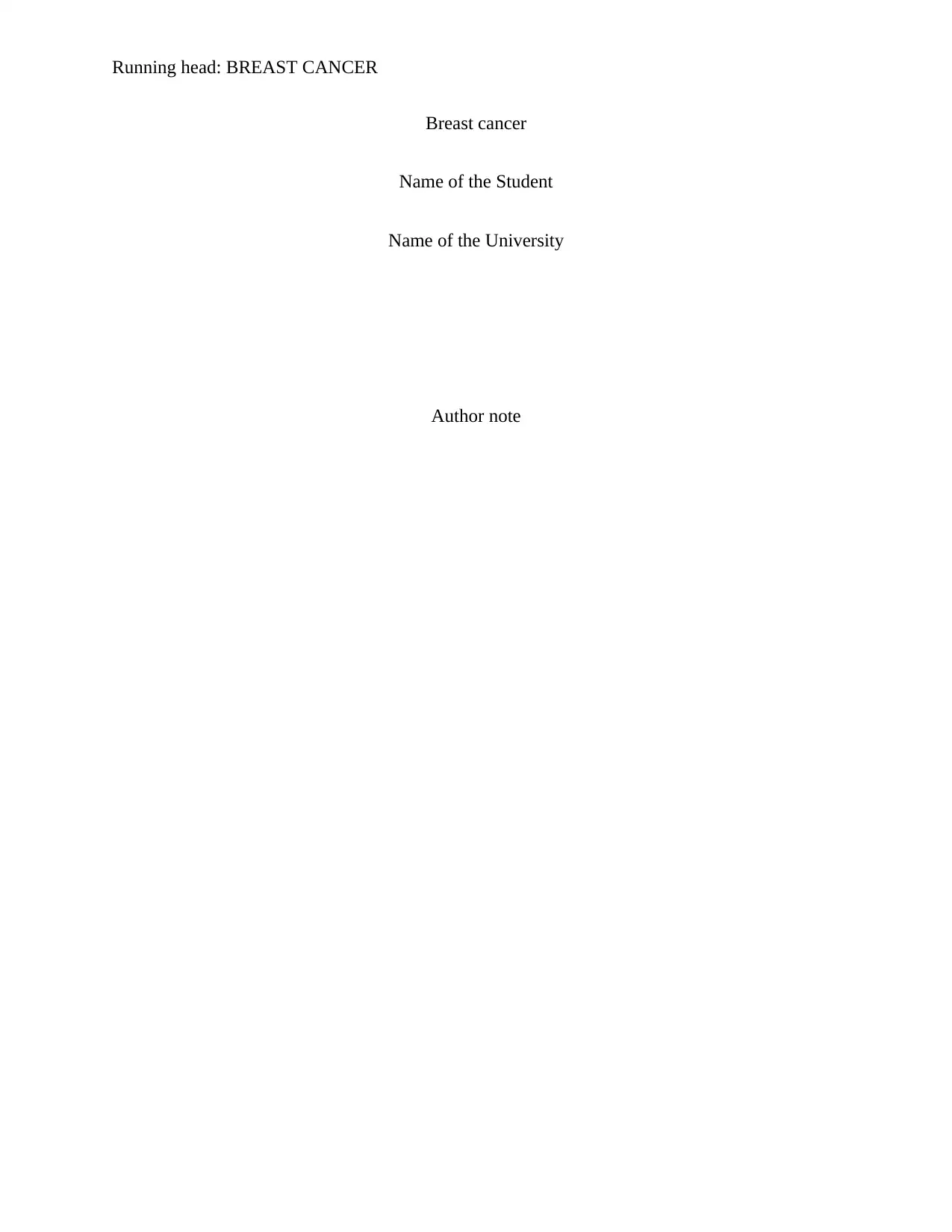
Running head: BREAST CANCER
Breast cancer
Name of the Student
Name of the University
Author note
Breast cancer
Name of the Student
Name of the University
Author note
Paraphrase This Document
Need a fresh take? Get an instant paraphrase of this document with our AI Paraphraser
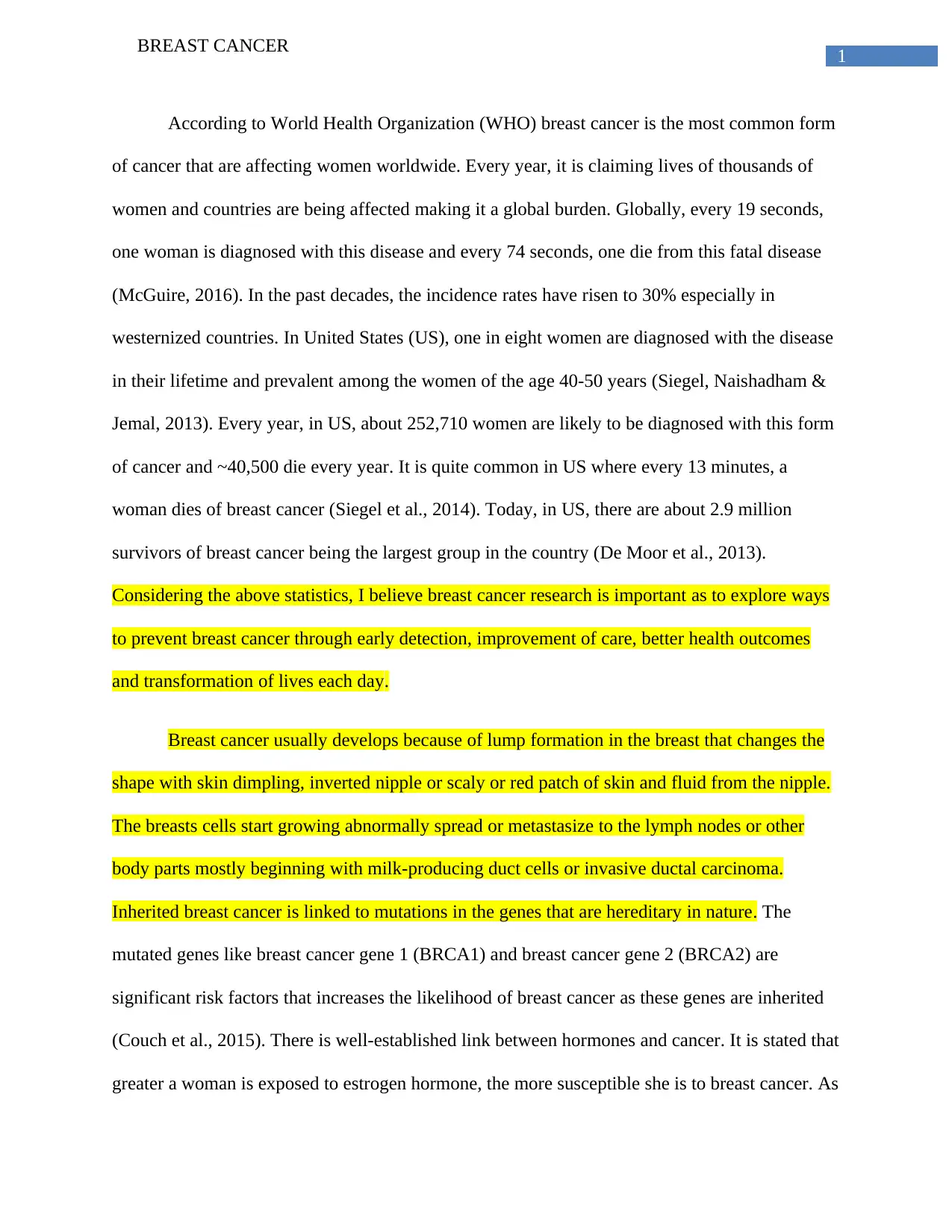
1
BREAST CANCER
According to World Health Organization (WHO) breast cancer is the most common form
of cancer that are affecting women worldwide. Every year, it is claiming lives of thousands of
women and countries are being affected making it a global burden. Globally, every 19 seconds,
one woman is diagnosed with this disease and every 74 seconds, one die from this fatal disease
(McGuire, 2016). In the past decades, the incidence rates have risen to 30% especially in
westernized countries. In United States (US), one in eight women are diagnosed with the disease
in their lifetime and prevalent among the women of the age 40-50 years (Siegel, Naishadham &
Jemal, 2013). Every year, in US, about 252,710 women are likely to be diagnosed with this form
of cancer and ~40,500 die every year. It is quite common in US where every 13 minutes, a
woman dies of breast cancer (Siegel et al., 2014). Today, in US, there are about 2.9 million
survivors of breast cancer being the largest group in the country (De Moor et al., 2013).
Considering the above statistics, I believe breast cancer research is important as to explore ways
to prevent breast cancer through early detection, improvement of care, better health outcomes
and transformation of lives each day.
Breast cancer usually develops because of lump formation in the breast that changes the
shape with skin dimpling, inverted nipple or scaly or red patch of skin and fluid from the nipple.
The breasts cells start growing abnormally spread or metastasize to the lymph nodes or other
body parts mostly beginning with milk-producing duct cells or invasive ductal carcinoma.
Inherited breast cancer is linked to mutations in the genes that are hereditary in nature. The
mutated genes like breast cancer gene 1 (BRCA1) and breast cancer gene 2 (BRCA2) are
significant risk factors that increases the likelihood of breast cancer as these genes are inherited
(Couch et al., 2015). There is well-established link between hormones and cancer. It is stated that
greater a woman is exposed to estrogen hormone, the more susceptible she is to breast cancer. As
BREAST CANCER
According to World Health Organization (WHO) breast cancer is the most common form
of cancer that are affecting women worldwide. Every year, it is claiming lives of thousands of
women and countries are being affected making it a global burden. Globally, every 19 seconds,
one woman is diagnosed with this disease and every 74 seconds, one die from this fatal disease
(McGuire, 2016). In the past decades, the incidence rates have risen to 30% especially in
westernized countries. In United States (US), one in eight women are diagnosed with the disease
in their lifetime and prevalent among the women of the age 40-50 years (Siegel, Naishadham &
Jemal, 2013). Every year, in US, about 252,710 women are likely to be diagnosed with this form
of cancer and ~40,500 die every year. It is quite common in US where every 13 minutes, a
woman dies of breast cancer (Siegel et al., 2014). Today, in US, there are about 2.9 million
survivors of breast cancer being the largest group in the country (De Moor et al., 2013).
Considering the above statistics, I believe breast cancer research is important as to explore ways
to prevent breast cancer through early detection, improvement of care, better health outcomes
and transformation of lives each day.
Breast cancer usually develops because of lump formation in the breast that changes the
shape with skin dimpling, inverted nipple or scaly or red patch of skin and fluid from the nipple.
The breasts cells start growing abnormally spread or metastasize to the lymph nodes or other
body parts mostly beginning with milk-producing duct cells or invasive ductal carcinoma.
Inherited breast cancer is linked to mutations in the genes that are hereditary in nature. The
mutated genes like breast cancer gene 1 (BRCA1) and breast cancer gene 2 (BRCA2) are
significant risk factors that increases the likelihood of breast cancer as these genes are inherited
(Couch et al., 2015). There is well-established link between hormones and cancer. It is stated that
greater a woman is exposed to estrogen hormone, the more susceptible she is to breast cancer. As
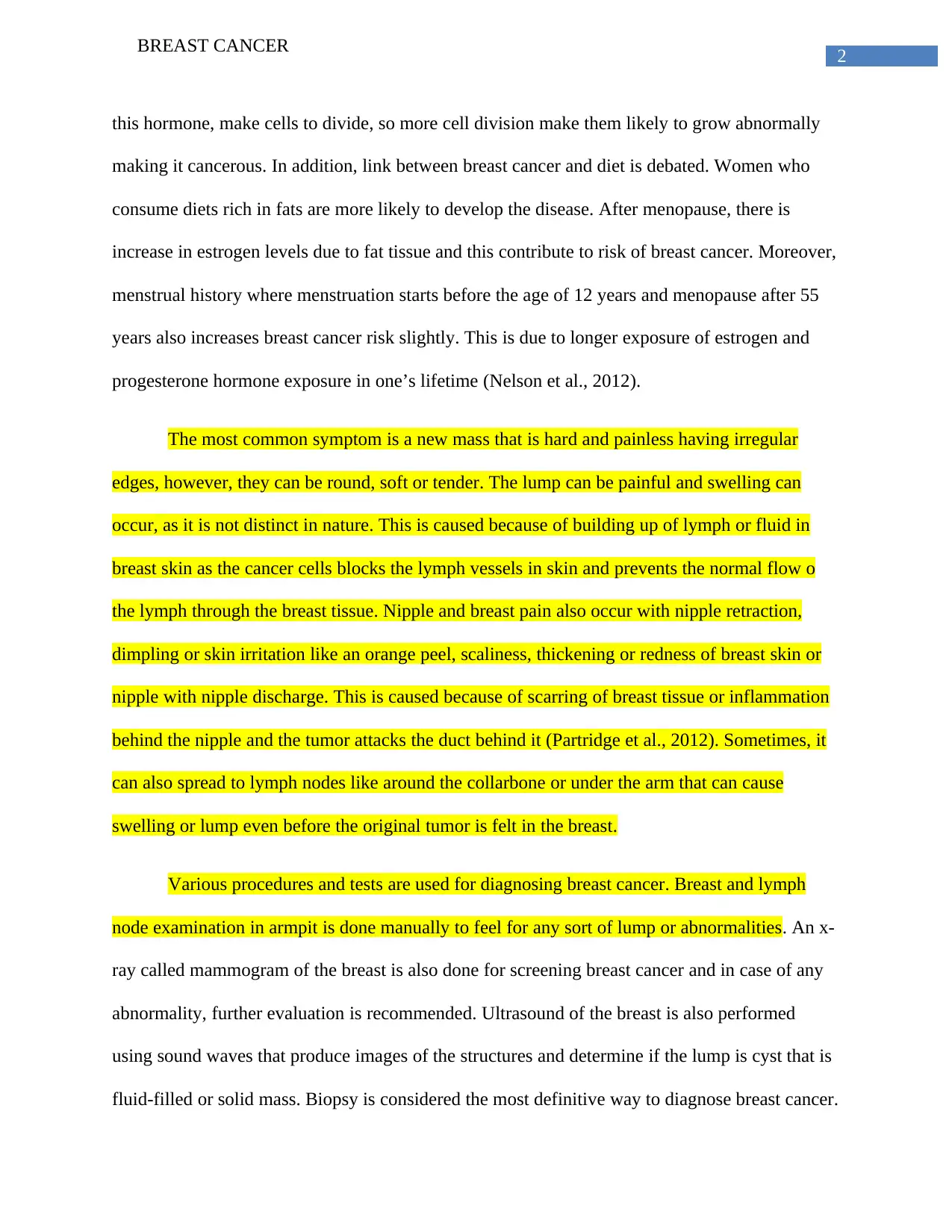
2
BREAST CANCER
this hormone, make cells to divide, so more cell division make them likely to grow abnormally
making it cancerous. In addition, link between breast cancer and diet is debated. Women who
consume diets rich in fats are more likely to develop the disease. After menopause, there is
increase in estrogen levels due to fat tissue and this contribute to risk of breast cancer. Moreover,
menstrual history where menstruation starts before the age of 12 years and menopause after 55
years also increases breast cancer risk slightly. This is due to longer exposure of estrogen and
progesterone hormone exposure in one’s lifetime (Nelson et al., 2012).
The most common symptom is a new mass that is hard and painless having irregular
edges, however, they can be round, soft or tender. The lump can be painful and swelling can
occur, as it is not distinct in nature. This is caused because of building up of lymph or fluid in
breast skin as the cancer cells blocks the lymph vessels in skin and prevents the normal flow o
the lymph through the breast tissue. Nipple and breast pain also occur with nipple retraction,
dimpling or skin irritation like an orange peel, scaliness, thickening or redness of breast skin or
nipple with nipple discharge. This is caused because of scarring of breast tissue or inflammation
behind the nipple and the tumor attacks the duct behind it (Partridge et al., 2012). Sometimes, it
can also spread to lymph nodes like around the collarbone or under the arm that can cause
swelling or lump even before the original tumor is felt in the breast.
Various procedures and tests are used for diagnosing breast cancer. Breast and lymph
node examination in armpit is done manually to feel for any sort of lump or abnormalities. An x-
ray called mammogram of the breast is also done for screening breast cancer and in case of any
abnormality, further evaluation is recommended. Ultrasound of the breast is also performed
using sound waves that produce images of the structures and determine if the lump is cyst that is
fluid-filled or solid mass. Biopsy is considered the most definitive way to diagnose breast cancer.
BREAST CANCER
this hormone, make cells to divide, so more cell division make them likely to grow abnormally
making it cancerous. In addition, link between breast cancer and diet is debated. Women who
consume diets rich in fats are more likely to develop the disease. After menopause, there is
increase in estrogen levels due to fat tissue and this contribute to risk of breast cancer. Moreover,
menstrual history where menstruation starts before the age of 12 years and menopause after 55
years also increases breast cancer risk slightly. This is due to longer exposure of estrogen and
progesterone hormone exposure in one’s lifetime (Nelson et al., 2012).
The most common symptom is a new mass that is hard and painless having irregular
edges, however, they can be round, soft or tender. The lump can be painful and swelling can
occur, as it is not distinct in nature. This is caused because of building up of lymph or fluid in
breast skin as the cancer cells blocks the lymph vessels in skin and prevents the normal flow o
the lymph through the breast tissue. Nipple and breast pain also occur with nipple retraction,
dimpling or skin irritation like an orange peel, scaliness, thickening or redness of breast skin or
nipple with nipple discharge. This is caused because of scarring of breast tissue or inflammation
behind the nipple and the tumor attacks the duct behind it (Partridge et al., 2012). Sometimes, it
can also spread to lymph nodes like around the collarbone or under the arm that can cause
swelling or lump even before the original tumor is felt in the breast.
Various procedures and tests are used for diagnosing breast cancer. Breast and lymph
node examination in armpit is done manually to feel for any sort of lump or abnormalities. An x-
ray called mammogram of the breast is also done for screening breast cancer and in case of any
abnormality, further evaluation is recommended. Ultrasound of the breast is also performed
using sound waves that produce images of the structures and determine if the lump is cyst that is
fluid-filled or solid mass. Biopsy is considered the most definitive way to diagnose breast cancer.
⊘ This is a preview!⊘
Do you want full access?
Subscribe today to unlock all pages.

Trusted by 1+ million students worldwide
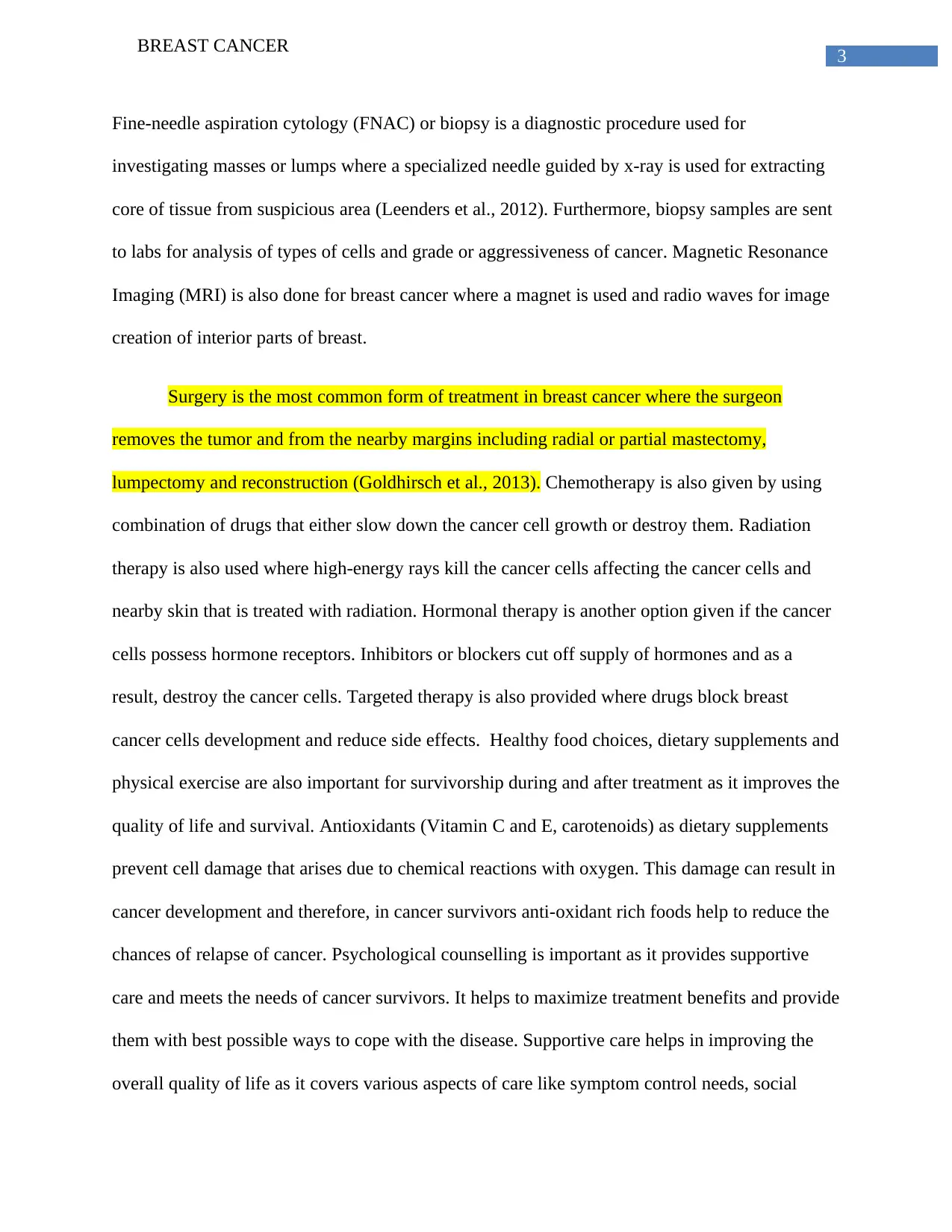
3
BREAST CANCER
Fine-needle aspiration cytology (FNAC) or biopsy is a diagnostic procedure used for
investigating masses or lumps where a specialized needle guided by x-ray is used for extracting
core of tissue from suspicious area (Leenders et al., 2012). Furthermore, biopsy samples are sent
to labs for analysis of types of cells and grade or aggressiveness of cancer. Magnetic Resonance
Imaging (MRI) is also done for breast cancer where a magnet is used and radio waves for image
creation of interior parts of breast.
Surgery is the most common form of treatment in breast cancer where the surgeon
removes the tumor and from the nearby margins including radial or partial mastectomy,
lumpectomy and reconstruction (Goldhirsch et al., 2013). Chemotherapy is also given by using
combination of drugs that either slow down the cancer cell growth or destroy them. Radiation
therapy is also used where high-energy rays kill the cancer cells affecting the cancer cells and
nearby skin that is treated with radiation. Hormonal therapy is another option given if the cancer
cells possess hormone receptors. Inhibitors or blockers cut off supply of hormones and as a
result, destroy the cancer cells. Targeted therapy is also provided where drugs block breast
cancer cells development and reduce side effects. Healthy food choices, dietary supplements and
physical exercise are also important for survivorship during and after treatment as it improves the
quality of life and survival. Antioxidants (Vitamin C and E, carotenoids) as dietary supplements
prevent cell damage that arises due to chemical reactions with oxygen. This damage can result in
cancer development and therefore, in cancer survivors anti-oxidant rich foods help to reduce the
chances of relapse of cancer. Psychological counselling is important as it provides supportive
care and meets the needs of cancer survivors. It helps to maximize treatment benefits and provide
them with best possible ways to cope with the disease. Supportive care helps in improving the
overall quality of life as it covers various aspects of care like symptom control needs, social
BREAST CANCER
Fine-needle aspiration cytology (FNAC) or biopsy is a diagnostic procedure used for
investigating masses or lumps where a specialized needle guided by x-ray is used for extracting
core of tissue from suspicious area (Leenders et al., 2012). Furthermore, biopsy samples are sent
to labs for analysis of types of cells and grade or aggressiveness of cancer. Magnetic Resonance
Imaging (MRI) is also done for breast cancer where a magnet is used and radio waves for image
creation of interior parts of breast.
Surgery is the most common form of treatment in breast cancer where the surgeon
removes the tumor and from the nearby margins including radial or partial mastectomy,
lumpectomy and reconstruction (Goldhirsch et al., 2013). Chemotherapy is also given by using
combination of drugs that either slow down the cancer cell growth or destroy them. Radiation
therapy is also used where high-energy rays kill the cancer cells affecting the cancer cells and
nearby skin that is treated with radiation. Hormonal therapy is another option given if the cancer
cells possess hormone receptors. Inhibitors or blockers cut off supply of hormones and as a
result, destroy the cancer cells. Targeted therapy is also provided where drugs block breast
cancer cells development and reduce side effects. Healthy food choices, dietary supplements and
physical exercise are also important for survivorship during and after treatment as it improves the
quality of life and survival. Antioxidants (Vitamin C and E, carotenoids) as dietary supplements
prevent cell damage that arises due to chemical reactions with oxygen. This damage can result in
cancer development and therefore, in cancer survivors anti-oxidant rich foods help to reduce the
chances of relapse of cancer. Psychological counselling is important as it provides supportive
care and meets the needs of cancer survivors. It helps to maximize treatment benefits and provide
them with best possible ways to cope with the disease. Supportive care helps in improving the
overall quality of life as it covers various aspects of care like symptom control needs, social
Paraphrase This Document
Need a fresh take? Get an instant paraphrase of this document with our AI Paraphraser

4
BREAST CANCER
support, patient education needs, spiritual and psychological support that requires
multidisciplinary approach and coordination (Clark & Fallowfield, 2014). After cancer
treatment, follow-up or regular check-ups are mandatory to ensure changes in health and relapse
of cancer.
Chances for survival in breast cancer differ by stages. Early stage invasive (stages I and
II) or non-invasive breast cancers (stage 0) have better prognosis as compared to stages III and
IV (later stages). There is poorest diagnosis for stage IV or metastatic form of breast cancer as it
spread to lymph nodes or other body parts. Overall survival rates in breast cancer show the
percentage of individuals after diagnosis that varies by stages. Women diagnosed with stage 0, II
and I have higher survival rates as compared to stage III or IV (DeSantis et al., 2014). However,
these rates are averages and depend on diagnosis and treatment. In breast cancer prognosis,
survival rates depend on each individual, as each case is unique. Five-year survival rate is the
prognosis after being diagnosed with the disease.
From the above discussion, it can be concluded that breast cancer is one of the major
cause of death worldwide. In US, it is the major cause of cancer death among the women of 40-
50 years of age. It generally develops as lump that causes changes in the breast due to mutations
in breast cancer genes that are heritable within the generations. Painless and hard lumps, nipple
retraction and scarring of breast tissue occur being the most common symptoms. Diagnostic tests
like mammograms, biopsy (FNAC) are done for detecting breast cancer. Therefore,
multidisciplinary approach with supportive care and counselling can be helpful for better
prognosis and long-term care.
BREAST CANCER
support, patient education needs, spiritual and psychological support that requires
multidisciplinary approach and coordination (Clark & Fallowfield, 2014). After cancer
treatment, follow-up or regular check-ups are mandatory to ensure changes in health and relapse
of cancer.
Chances for survival in breast cancer differ by stages. Early stage invasive (stages I and
II) or non-invasive breast cancers (stage 0) have better prognosis as compared to stages III and
IV (later stages). There is poorest diagnosis for stage IV or metastatic form of breast cancer as it
spread to lymph nodes or other body parts. Overall survival rates in breast cancer show the
percentage of individuals after diagnosis that varies by stages. Women diagnosed with stage 0, II
and I have higher survival rates as compared to stage III or IV (DeSantis et al., 2014). However,
these rates are averages and depend on diagnosis and treatment. In breast cancer prognosis,
survival rates depend on each individual, as each case is unique. Five-year survival rate is the
prognosis after being diagnosed with the disease.
From the above discussion, it can be concluded that breast cancer is one of the major
cause of death worldwide. In US, it is the major cause of cancer death among the women of 40-
50 years of age. It generally develops as lump that causes changes in the breast due to mutations
in breast cancer genes that are heritable within the generations. Painless and hard lumps, nipple
retraction and scarring of breast tissue occur being the most common symptoms. Diagnostic tests
like mammograms, biopsy (FNAC) are done for detecting breast cancer. Therefore,
multidisciplinary approach with supportive care and counselling can be helpful for better
prognosis and long-term care.
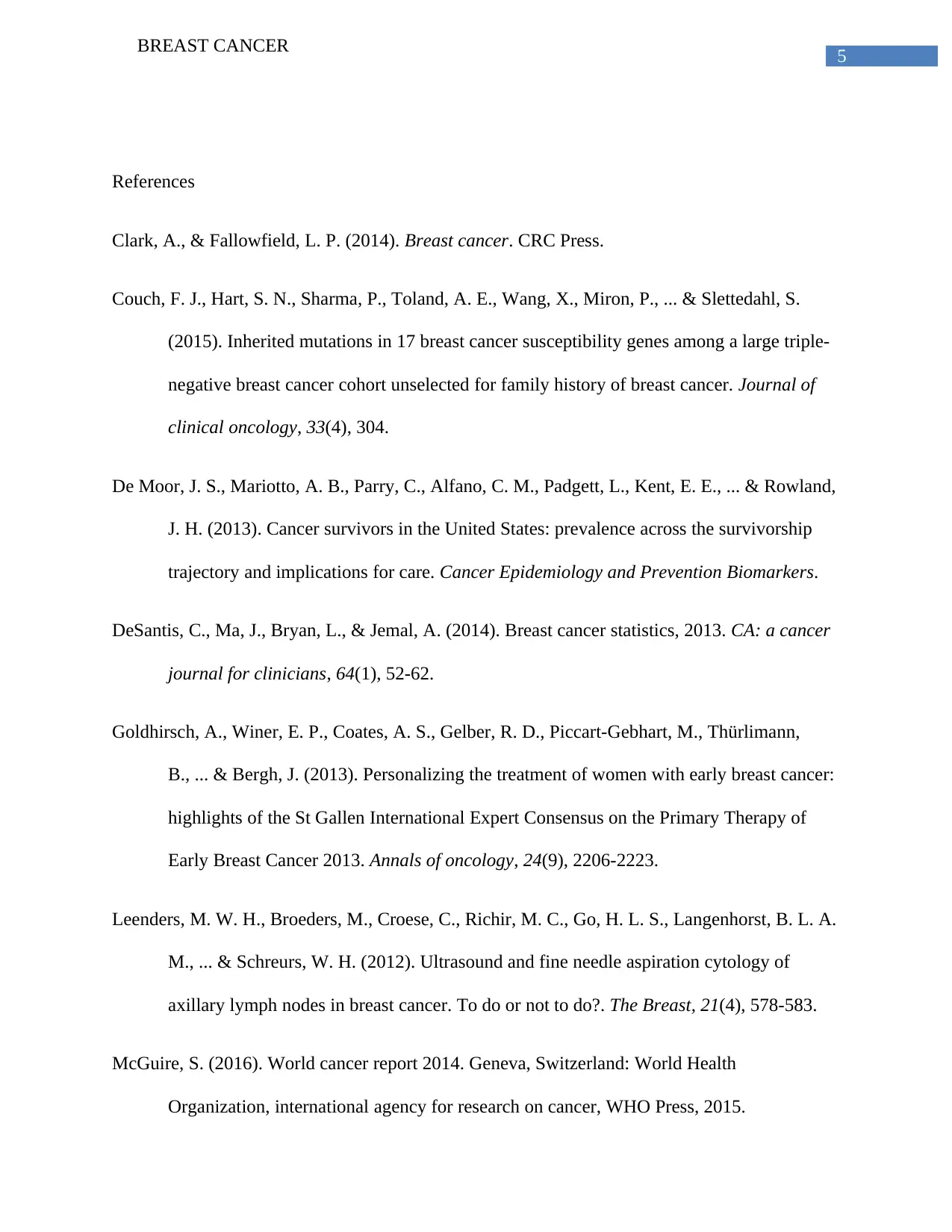
5
BREAST CANCER
References
Clark, A., & Fallowfield, L. P. (2014). Breast cancer. CRC Press.
Couch, F. J., Hart, S. N., Sharma, P., Toland, A. E., Wang, X., Miron, P., ... & Slettedahl, S.
(2015). Inherited mutations in 17 breast cancer susceptibility genes among a large triple-
negative breast cancer cohort unselected for family history of breast cancer. Journal of
clinical oncology, 33(4), 304.
De Moor, J. S., Mariotto, A. B., Parry, C., Alfano, C. M., Padgett, L., Kent, E. E., ... & Rowland,
J. H. (2013). Cancer survivors in the United States: prevalence across the survivorship
trajectory and implications for care. Cancer Epidemiology and Prevention Biomarkers.
DeSantis, C., Ma, J., Bryan, L., & Jemal, A. (2014). Breast cancer statistics, 2013. CA: a cancer
journal for clinicians, 64(1), 52-62.
Goldhirsch, A., Winer, E. P., Coates, A. S., Gelber, R. D., Piccart-Gebhart, M., Thürlimann,
B., ... & Bergh, J. (2013). Personalizing the treatment of women with early breast cancer:
highlights of the St Gallen International Expert Consensus on the Primary Therapy of
Early Breast Cancer 2013. Annals of oncology, 24(9), 2206-2223.
Leenders, M. W. H., Broeders, M., Croese, C., Richir, M. C., Go, H. L. S., Langenhorst, B. L. A.
M., ... & Schreurs, W. H. (2012). Ultrasound and fine needle aspiration cytology of
axillary lymph nodes in breast cancer. To do or not to do?. The Breast, 21(4), 578-583.
McGuire, S. (2016). World cancer report 2014. Geneva, Switzerland: World Health
Organization, international agency for research on cancer, WHO Press, 2015.
BREAST CANCER
References
Clark, A., & Fallowfield, L. P. (2014). Breast cancer. CRC Press.
Couch, F. J., Hart, S. N., Sharma, P., Toland, A. E., Wang, X., Miron, P., ... & Slettedahl, S.
(2015). Inherited mutations in 17 breast cancer susceptibility genes among a large triple-
negative breast cancer cohort unselected for family history of breast cancer. Journal of
clinical oncology, 33(4), 304.
De Moor, J. S., Mariotto, A. B., Parry, C., Alfano, C. M., Padgett, L., Kent, E. E., ... & Rowland,
J. H. (2013). Cancer survivors in the United States: prevalence across the survivorship
trajectory and implications for care. Cancer Epidemiology and Prevention Biomarkers.
DeSantis, C., Ma, J., Bryan, L., & Jemal, A. (2014). Breast cancer statistics, 2013. CA: a cancer
journal for clinicians, 64(1), 52-62.
Goldhirsch, A., Winer, E. P., Coates, A. S., Gelber, R. D., Piccart-Gebhart, M., Thürlimann,
B., ... & Bergh, J. (2013). Personalizing the treatment of women with early breast cancer:
highlights of the St Gallen International Expert Consensus on the Primary Therapy of
Early Breast Cancer 2013. Annals of oncology, 24(9), 2206-2223.
Leenders, M. W. H., Broeders, M., Croese, C., Richir, M. C., Go, H. L. S., Langenhorst, B. L. A.
M., ... & Schreurs, W. H. (2012). Ultrasound and fine needle aspiration cytology of
axillary lymph nodes in breast cancer. To do or not to do?. The Breast, 21(4), 578-583.
McGuire, S. (2016). World cancer report 2014. Geneva, Switzerland: World Health
Organization, international agency for research on cancer, WHO Press, 2015.
⊘ This is a preview!⊘
Do you want full access?
Subscribe today to unlock all pages.

Trusted by 1+ million students worldwide

6
BREAST CANCER
Nelson, H. D., Zakher, B., Cantor, A., Fu, R., Griffin, J., O'meara, E. S., ... & Mandelblatt, J. S.
(2012). Risk factors for breast cancer for women aged 40 to 49 years: a systematic review
and meta-analysis. Annals of internal medicine, 156(9), 635-648.
Partridge, A. H., Hughes, M. E., Ottesen, R. A., Wong, Y. N., Edge, S. B., Theriault, R. L., ... &
Tamimi, R. M. (2012). The effect of age on delay in diagnosis and stage of breast
cancer. The oncologist, 17(6), 775-782.
Siegel, R., Ma, J., Zou, Z., & Jemal, A. (2014). Cancer statistics, 2014. CA: a cancer journal for
clinicians, 64(1), 9-29.
Siegel, R., Naishadham, D., & Jemal, A. (2013). Cancer statistics, 2013. CA: a cancer journal
for clinicians, 63(1), 11-30.
BREAST CANCER
Nelson, H. D., Zakher, B., Cantor, A., Fu, R., Griffin, J., O'meara, E. S., ... & Mandelblatt, J. S.
(2012). Risk factors for breast cancer for women aged 40 to 49 years: a systematic review
and meta-analysis. Annals of internal medicine, 156(9), 635-648.
Partridge, A. H., Hughes, M. E., Ottesen, R. A., Wong, Y. N., Edge, S. B., Theriault, R. L., ... &
Tamimi, R. M. (2012). The effect of age on delay in diagnosis and stage of breast
cancer. The oncologist, 17(6), 775-782.
Siegel, R., Ma, J., Zou, Z., & Jemal, A. (2014). Cancer statistics, 2014. CA: a cancer journal for
clinicians, 64(1), 9-29.
Siegel, R., Naishadham, D., & Jemal, A. (2013). Cancer statistics, 2013. CA: a cancer journal
for clinicians, 63(1), 11-30.
1 out of 7
Related Documents
Your All-in-One AI-Powered Toolkit for Academic Success.
+13062052269
info@desklib.com
Available 24*7 on WhatsApp / Email
![[object Object]](/_next/static/media/star-bottom.7253800d.svg)
Unlock your academic potential
Copyright © 2020–2025 A2Z Services. All Rights Reserved. Developed and managed by ZUCOL.





